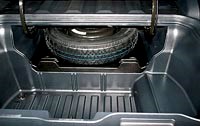2005 NAIA Show highlights
Detroit Auto Show emphasizes powerful and eco-friendly vehicles.
The North American International Auto Show (Jan. 15-23, in Detroit, Mich.) again demonstrated it is a prime forum for production and concept vehicle introductions from both domestic and international OEMs. While many of the new vehicles emphasized power and size, almost as many, especially among the concepts, targeted reductions in fuel consumption via weight reduction, hybrid fuel/electric powertrains or hydrogen-based fuel cells. In the weight reduction category, both aluminum and composites were presented as viable materials to achieve this aim.
Prominent among the innovations were two new pickup trucks with compression molded SMC (sheet molding compound) beds as standard items. The Toyota Tacoma has a one-piece box produced by ThyssenKrupp Budd (Troy, Mich.). Scheduled for production of 180,000 units this year, the box weighs 10 percent less than a stamped and welded steel box and saved Toyota 50 percent on tooling costs, according to Mike Dorney, VP of sales for ThyssenKrupp Budd. Attracting even more attention was Honda's Ridgeline, the company's first pickup to be sold in North America. Assembled in Canada, the full-size truck integrates a multipiece, hybrid polyester/vinyl ester SMC box with a first-ever built-in "trunk" (photo below), capable of holding as many as three golf bags or a 68L/72-qt cooler. Furnished by Meridian Automotive Systems (Dearborn, Mich.) and produced using SMC, the entire assembly weighs only 120 lb/55 kg. The floor unit, integrating the trunk and spare wheel area, consists of four moldings that are assembled by Meridian and supplied to Honda as a kit, with the sidewalls, bulkhead and tailgate inner panel. A spatter paint process provides anti-skid characteristics and UV protection. "I don't think this design would even be practical in steel," emphasizes David White, Meridian's VP of sales/marketing. Honda started with a clean sheet of paper and no entrenched metal stamping capacity in North America, thus realizing considerable savings in tooling, equipment and weight. The box has entered low-rate production, but manufacture of 50,000 to 60,000 units is expected this year.
Sports car fans were treated to the 2006-model Chevrolet Corvette Z06 (photo at right), introduced with a larger 500-hp, 7.0L engine. The car weighs less than the base Corvette C-6 introduced last year, via the use of lightweight materials in the structure and body. Like the base car, the Z06 has SMC doors, hood, rear quarter panels and roof. The steel in the frame has been replaced with aluminum. Carbon fiber has replaced fiberglass in the floor panels and wheelhouses, which are compression molded by Molded Fiber Glass Co. (MFG, Ashtabula, Ohio), using carbon fiber from Toray Carbon Fibers America (Flower Mound, Texas) and polyester resin from Ashland Specialty Chemical (Columbus, Ohio). The molding process involves a specially prepared, needled mat produced in-house by MFG and, in the case of the floor, a balsa wood core supplied by Alcan Baltek (Northvale, N.J.). For the front fenders, GM built on the experience obtained from the 2004 Z06 carbon hood, specifying autoclave-cured carbon fiber fenders produced by Vermont Composites (Bennington, Vt.). Each fender, made from unidirectional prepreg (Toray Composites America, Tacoma, Wash.), weighs less than 1.4kg/3 lb -- considerably lighter than the 4 kg/9 lb polyurethane RIM-based versions used on the base Corvette. The Z06 goes on sale later in 2005.
The MomentUM solar-powered car, built by the Michigan Solar Car Team (University of Michigan), features a carbon-fiber epoxy body. The tooling featured Ashland's (Dublin, Ohio) AROTOOL 2001 resin and tooling gel coat.
Also on display was the Genus Concept Seat, a visionary prototype from Johnson Controls (Milwaukee, Wis.). The sleek, thin-profile, exposed composite structure features a cantilevered base and under-seat courtesy lighting. Its active Live Back seating surfaces, introduced by Steelcase Inc. (Grand Rapids, Mich.), conform automatically to the occupant's "spineprint," a reading of body shape and position within the seat.
-- Dale Brosius
Related Content
Composite resins price change report
CW’s running summary of resin price change announcements from major material suppliers that serve the composites manufacturing industry.
Read MoreMar-Bal expands SMC expertise through AltraSet materials division
The BMC company aims to fill the SMC market gap for those seeking optimal, low-volume demand with custom formulation and high material value.
Read MoreCo-molding SMC with braided glass fiber demonstrates truck bed potential
Prepreg co-molding compound by IDI Composites International and A&P Technology enables new geometries and levels of strength and resiliency for automotive, mobility.
Read MoreAOC introduces UV-Resistant Automotive System for SMC parts
AOC’s novel formulation, tested in the lab and in real-world environments, delivers a deep black, molded-in color that resists fading and offers high scratch resistance.
Read MoreRead Next
Plant tour: Daher Shap’in TechCenter and composites production plant, Saint-Aignan-de-Grandlieu, France
Co-located R&D and production advance OOA thermosets, thermoplastics, welding, recycling and digital technologies for faster processing and certification of lighter, more sustainable composites.
Read MoreDeveloping bonded composite repair for ships, offshore units
Bureau Veritas and industry partners issue guidelines and pave the way for certification via StrengthBond Offshore project.
Read More“Structured air” TPS safeguards composite structures
Powered by an 85% air/15% pure polyimide aerogel, Blueshift’s novel material system protects structures during transient thermal events from -200°C to beyond 2400°C for rockets, battery boxes and more.
Read More























